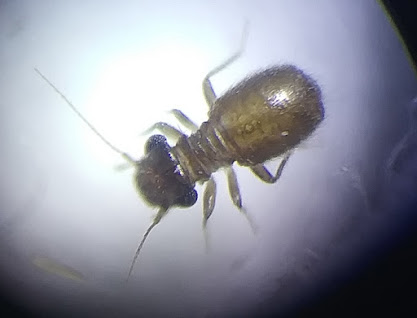I’m hoping you’ll enjoy seeing what I do when the weather is sour and I want a dose of nature. I’ve enjoying a whole new arena of wildlife.
I’ve been attending a zoom nature journaling conference ... one of the sessions was a ’Plankton Microscope Expedition.’ That got me thinking about my very nice microscope that has been gathering dust for over 20 years. I traded a painting for it about 40 years ago and shared it with my young daughters until the electrical cord came out (no fault of theirs). Dale tried to fix it, but my memory said it still didn’t work... would it light up?
I plugged it in and had light for about two minutes ... just long enough to really wet my appetite. Necessity is the mother of invention. I soon found I could see very well using a LED flash light! I can either shine the light down onto the slide, or up from underneath.
First I went to a soggy puddle in my backyard and found lots of tiny, tiny little specs of microscopic critters running in mad circles – like bumper cars at the county fair. I think they are water fleas. How do they get there? In summer that dip in the lawn is bone dry, but during the soggy parts of winter the puddle is an obstacle on my way to my compost pile.
Next I harvested a tuft of mosses and lichens off the bark on my honey locust tree. It was easy to find a half inch grub, but what really amazed me was a tiny insect -- 2 mm in length (3/32 of an inch). Remember, adult insects don’t keep on growing. This was an adult. I could hardly see it.
I have a glass slide with a little scoop out where I can trap something so small. I put a wafer of glass on top of the scoop out and trapped him long enough to look at him. I wasn’t sure what it was until I saw two pairs of wings and fairly long antennae – definitely not a fly and probably a tiny wasp! I penciled him looking through the microscope and after I released, it I painted a clone. It was so small the wings don’t even have veins, just little speckles and a fringe of hairs.
Next day I took my exploration even farther. Drawing through the microscope is hard ... the little critters keep zipping out of my field of view. I wanted to photograph my finds. I actually found another wasp, trapped it on my slide again and started experimenting. It’s hard. I really need three hands: one to push the slide around, one to focus the microscope, and one to hold my cell phone in position. But it is possible! I even have a transparent ruler I can put under on the slide and measure pretty accurately.
I submitted my wasp to www.Bugguide.net and verified it really is a wasp, probably Trichopria sp.
This little cutie is a booklouse: Reticulate-winged trogid – Lepinotus reticulatus. He is just under one millimeter!
... and this is a slender springtail, Entomobrya katzi– all of 1.5 mm. He created a flurry of e-mails on Bug Guide. He is the first submission since a change in the scientific name.
... and a baby spider – about 1 mm.
What will I find next?








